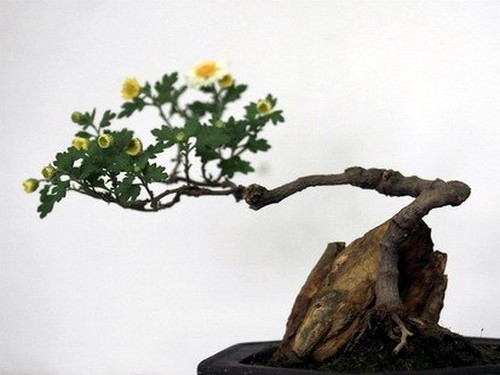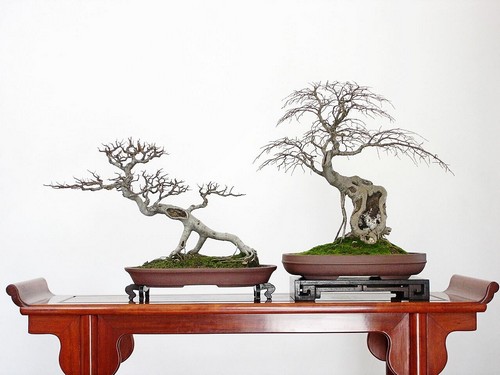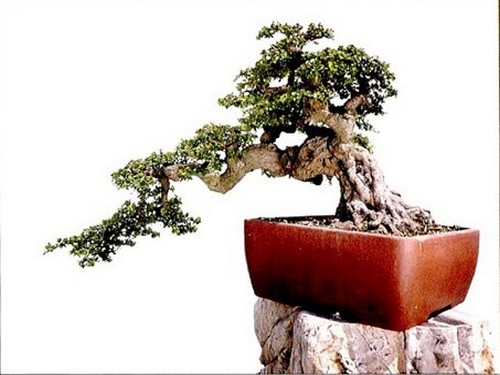Making methods of different shapes of Chrysanthemum Bonsai
Chrysanthemum is a perennial herbaceous flower of the genus Compositae. The stem is herbaceous and slightly Lignified at the end of its growth. After flowering every year, the aboveground parts wither, leaving persistent roots to survive the winter, and new branches sprout in the next spring. Stem erect or semi-spreading, surface pubescent, easily branched, in the state of natural growth, up to 80ml 150 cm. Chrysanthemum is one of the most complex flowers in the world.
Chrysanthemum bonsai has several advantages such as long flowering period, many varieties, complete colors and easy maintenance. The common shapes are cliff type, single-dry type, oblique dry type, jungle type or stone-attached type, wood-attached type and miniature chrysanthemum bonsai, chrysanthemum pictures imitating traditional Chinese painting and so on.

1. Making cliff-style bonsai:
Make use of the natural upward habit of the chrysanthemum seedling to bend the chrysanthemum seedling into a sagging shape, and fix the trunk of the chrysanthemum seedling next to the bowl wall with thin wire or rope. In autumn, when the bud of the chrysanthemum is about to open, replace it with a thin pot, remove the wire or tie the rope, and cover the basin with some moss, so that an elegant cliff-style chrysanthemum bonsai is unfolded in front of you.
2. Making stone-attached chrysanthemum bonsai:
First find a good shape of the rock, to have distinct levels, scattered. In May, the nurtured chrysanthemum seedlings were moved to the rocks, mainly by attaching the roots to the rocks, and then cultured together in large tile pots. Wait until the autumn buds are about to bloom, and then transplant them into purple sand pots or porcelain pots of suitable size and depth. Stone-attached chrysanthemum bonsai combines the ruggedness of mountains and rocks with the delicacy of chrysanthemums to complement each other.
3. Make wood-attached chrysanthemum bonsai:
Should choose the vigorous and simple dead tree stump, chisel out the groove about the width of 2~3cm in the back of the tree, buckle the plant from the tile basin in early summer, put the branches in the chiseled groove on the back of the dead tree stump, fix it with wire or rope, then plant it into a larger tile basin for maintenance, and move them into the purple sand basin in autumn. The withered and mottled stump, the strange ancient times and the fineness of the chrysanthemum set off each other, setting off the withered and old stump with the blooming leaves of the chrysanthemum.
4. Make ammonite bonsai:
Choose a rectangular or oval purple sand basin and plant chrysanthemums on one or both sides, but do not plant in the middle of the flowerpot, with suitable rocks, in the form of a "chrysanthemum picture" in traditional Chinese painting.
Although there are ways to make chrysanthemum bonsai, no matter which form of chrysanthemum bonsai should be a pleasing organism. Of course, the most important thing is that you like it.
Time: 2019-05-26 Click:
- Prev

The method of making Pushu bonsai
Pushu is a subtropical tree species produced in the Huaihe River Basin, south of Qinling Mountains, as far as Guangdong, Guangxi and other provinces and regions. Most of them are scattered in plain and low mountain areas. Like light, suitable for warm and humid climate, suitable for growing in fertile and flat land. Lax requirements on the soil, a certain degree of resistance to dry, but also resistant to water and moisture and barren soil, strong adaptability
- Next

The method of making Fujian Tea Bonsai
Fujian tea is produced in Guangdong, Fujian, Taiwan and other provinces in southern China. It is also distributed in the tropics of southern and southeastern Asia. Fujian tea, also known as base tree and cat tree, is an evergreen shrub of Arnebiaceae. The leaves are small, long oval, dark green and shiny. White florets bloom in spring and summer, drupe globose, red after green. It has a rugged trunk.
Related
- Fuxing push coffee new agricultural production and marketing class: lack of small-scale processing plants
- Jujube rice field leisure farm deep ploughing Yilan for five years to create a space for organic food and play
- Nongyu Farm-A trial of organic papaya for brave women with advanced technology
- Four points for attention in the prevention and control of diseases and insect pests of edible fungi
- How to add nutrient solution to Edible Fungi
- Is there any good way to control edible fungus mites?
- Open Inoculation Technology of Edible Fungi
- Is there any clever way to use fertilizer for edible fungus in winter?
- What agents are used to kill the pathogens of edible fungi in the mushroom shed?
- Rapid drying of Edible Fungi

